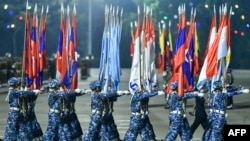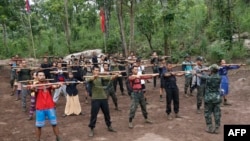Myanmar’s ruling junta, the State Administrative Council, is criticizing a U.S. aid package that is being funneled through opponents of the regime, saying the United States should consider whether its actions amount to support for terrorism.
The assistance marks the first implementation of the BURMA Act, part of the 2023 National Defense Authorization Act aimed at helping pro-democracy forces battling the SAC.
Under the act, the aid is intended to strengthen federalism in Myanmar by providing nonlethal assistance to armed groups, helping pro-democracy organizations, assisting aid organizations operating from Thailand, and financing investigations of junta human rights violations. The aid is restricted to ensure it does not benefit the SAC or any entity affiliated with the Myanmar military.
“We believe the U.S. is manipulating Myanmar to counter China's influence in the region,” the junta said in a statement provided to VOA on March 29. “Despite the U.S. presenting itself as a champion of democracy, the aid disproportionately benefits Myanmar's opposition groups, particularly the National Unity Government (NUG) and the People's Defense Force (PDF).”
The NUG is the opposition’s shadow government; the PDF is made up of civilian armed groups battling the military.
The junta statement calls on the United States to review its aid allocation “to reassess whether their actions, which some label as terrorism, represent a legitimate path to reclaiming power.”
The junta, which has killed and imprisoned thousands of people since overthrowing the democratically elected government in February 2021, accuses the NUG and PDF of responsibility for the civilian deaths. The statement did not elaborate on the charge that U.S. support for resistance groups in Myanmar is linked to Myanmar’s adversarial relationship with China.
The promise of the BURMA Act
The Burma Unified Through Rigorous Military Accountability Act, commonly called the BURMA Act, says it aims to “continue to support the people of Burma in their struggle for democracy, human rights, and justice.”
It identifies specific resistance groups as beneficiaries, including the NUG, and the National Unity Consultative Council, or NUCC, which comprises several opposition groups.
Also named are the Committee Representing Pyidaungsu Hluttaw, which is made up of members of the ousted Myanmar parliament; the civil disobedience movement; "and other entities in Burma and in other countries” that seek to “bring about an end to the military junta’s rule.”
The act promises to “hold accountable perpetrators of human rights violations,” and to “hold accountable the Russian Federation and the People’s Republic of China.”
It provides $75 million for refugee assistance programs, including in Thailand and India, and $25 million for “technical support and non-lethal assistance” to the NUG and PDF. Smaller amounts are earmarked for governance programs, documentation of atrocities, and assistance to political prisoners, Rohingya and deserters from the junta’s military.
The Rohingya, a predominantly Muslim ethnic minority group, have faced persecution and discrimination in Myanmar for decades. In 2017, a military crackdown by the Myanmar army forced hundreds of thousands of Rohingya to flee to neighboring Bangladesh, seeking refuge from the violence and persecution.
The act authorizes appropriations to be allocated annually from fiscal years 2023 through 2027, with $121 million earmarked for FY 2024.
Process of the funding
During debate on the bill, the U.S. House of Representatives initially proposed a more limited $50 million aid package but agreed to the larger sum advocated by the Senate before final passage.
"We are pleased with the $121 million proposed by the Senate, instead of the $50 million proposed by the House. However, we believe this amount is insufficient, and should be closer to $300 million to meet the humanitarian needs on the ground,” said James Shwe, from the Los Angeles Myanmar Movement, which works with Myanmar activists in the United States.
In a Zoom call with VOA, Shwe also criticized what he sees as the high administrative costs of aid distribution.
“Because of the lack of state-to-state cooperation in a case such as Myanmar, where the aid is meant for humanitarian assistance, but not for the ruling power, this leads to several layers of management,” he said.
“The aid is funneled through USAID partners, the biggest of which is the U.N., which has to operate under the rules of the junta. In many cases, the U.N. will in turn deal with [non-governmental organizations]. The NGO then needs to distribute that aid to [civil society organizations] on the ground. This leads to ever-increasing administrative costs and less actual assistance to those in need.”
Shwe said administration costs eat up around 45% of aid funds.
“Only $75 million of the $121 million is allocated for cross-border aid, which we believe will be more effective than channeling funds through the U.N., the largest partner of USAID," Shwe added. But he welcomed the lawmakers’ decision to specifically name the NUG and the NUCC in the act, ensuring that they will play a role in the allocation of the funds.
Hopes for assistance amid U.S. engagement
Hopes for continued humanitarian assistance to Myanmar are on the rise after U.S. State Department Counselor Derek Chollet and USAID Assistant Administrator Michael Schiffer met this month with representatives from the NUG.
“The meeting underscores the ongoing commitment of the United States to engage with Myanmar's NUG leadership and support their endeavors to promote democracy, peace, and stability in the region,” said an April 11 State Department press release.
Chollet also met in late March with ethnic armed organizations allied with the NUG.
"Met today with leaders of Burma’s ‘K3C’ ethnic group alliance on their extraordinary efforts to pursue a federal democracy in Burma,” he wrote on X on March 28. “We discussed steps for the international community to expand assistance to those in need and secure a better future for the people of Burma."
The K3C alliance, comprising the Kachin Independence Organization, Karen National Union, Karenni National Progressive Party, and Chin National Front, is politically aligned with the NUG and collaborates militarily with its armed wing, the People’s Defense Force.
"We briefed them on the political and military situation in our state, as well as the humanitarian situation,” said Aung San Myint, secretary of the Karenni National Progressive Party, who shared details of the meeting with VOA by phone.
“Following our presentation, they assured us of continued collaboration as the U.S. Department of State. ... We have hope for increased humanitarian aid as discussions progress with U.S. officials."










